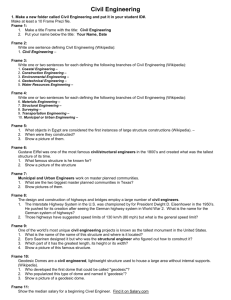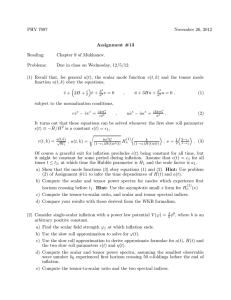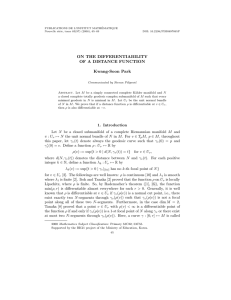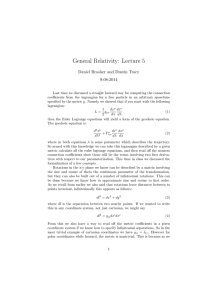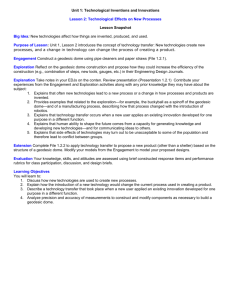Document 10835563
advertisement
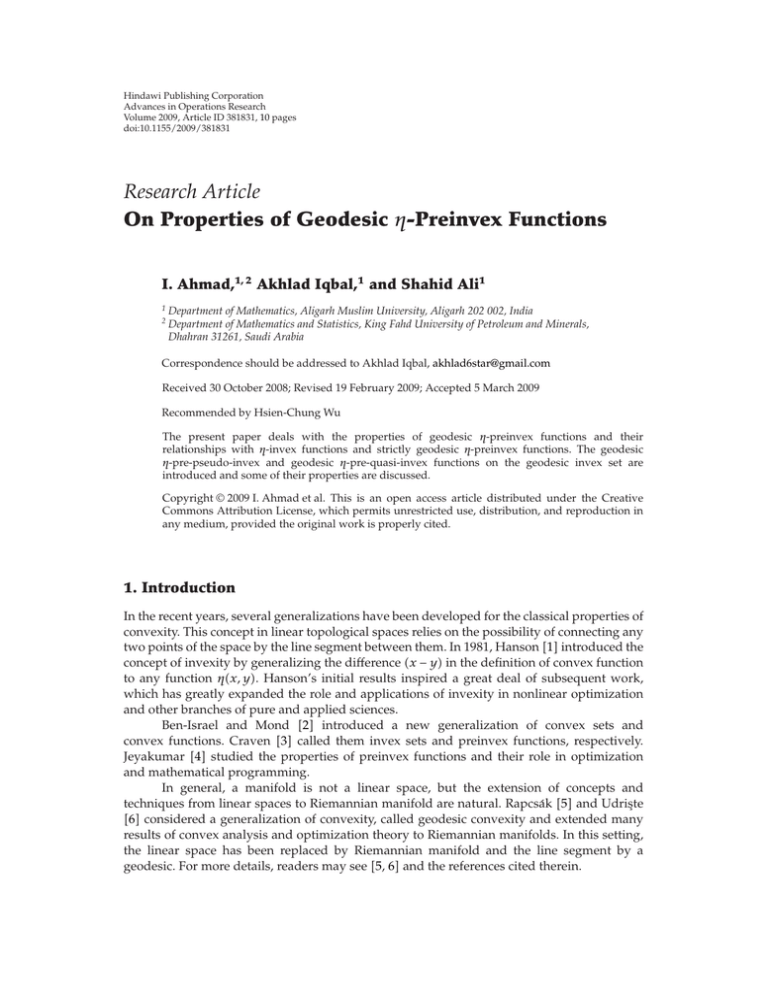
Hindawi Publishing Corporation
Advances in Operations Research
Volume 2009, Article ID 381831, 10 pages
doi:10.1155/2009/381831
Research Article
On Properties of Geodesic η-Preinvex Functions
I. Ahmad,1, 2 Akhlad Iqbal,1 and Shahid Ali1
1
2
Department of Mathematics, Aligarh Muslim University, Aligarh 202 002, India
Department of Mathematics and Statistics, King Fahd University of Petroleum and Minerals,
Dhahran 31261, Saudi Arabia
Correspondence should be addressed to Akhlad Iqbal, akhlad6star@gmail.com
Received 30 October 2008; Revised 19 February 2009; Accepted 5 March 2009
Recommended by Hsien-Chung Wu
The present paper deals with the properties of geodesic η-preinvex functions and their
relationships with η-invex functions and strictly geodesic η-preinvex functions. The geodesic
η-pre-pseudo-invex and geodesic η-pre-quasi-invex functions on the geodesic invex set are
introduced and some of their properties are discussed.
Copyright q 2009 I. Ahmad et al. This is an open access article distributed under the Creative
Commons Attribution License, which permits unrestricted use, distribution, and reproduction in
any medium, provided the original work is properly cited.
1. Introduction
In the recent years, several generalizations have been developed for the classical properties of
convexity. This concept in linear topological spaces relies on the possibility of connecting any
two points of the space by the line segment between them. In 1981, Hanson 1 introduced the
concept of invexity by generalizing the difference x − y in the definition of convex function
to any function ηx, y. Hanson’s initial results inspired a great deal of subsequent work,
which has greatly expanded the role and applications of invexity in nonlinear optimization
and other branches of pure and applied sciences.
Ben-Israel and Mond 2 introduced a new generalization of convex sets and
convex functions. Craven 3 called them invex sets and preinvex functions, respectively.
Jeyakumar 4 studied the properties of preinvex functions and their role in optimization
and mathematical programming.
In general, a manifold is not a linear space, but the extension of concepts and
techniques from linear spaces to Riemannian manifold are natural. Rapcsák 5 and Udrişte
6 considered a generalization of convexity, called geodesic convexity and extended many
results of convex analysis and optimization theory to Riemannian manifolds. In this setting,
the linear space has been replaced by Riemannian manifold and the line segment by a
geodesic. For more details, readers may see 5, 6 and the references cited therein.
2
Advances in Operations Research
The notion of invex functions on Riemannian manifold was introduced in 7,
however its generalization has been investigated by Mititelu 8. Barani and Pouryayevali
9 introduced the geodesic invex set, geodesic invex function and geodesic preinvex function
on Riemannian manifold with respect to particular maps, and studied the relations between
them.
In this paper, we discuss various concepts, definitions and properties for the
functions on Riemannian manifold. The notion of invexity and its generalization on
Riemannian manifold is recalled in Section 2. In Section 3, we discuss some properties
of geodesic η-preinvex functions and their relationships with η-invex functions. The
relationship between strictly geodesic η-preinvex function and geodesic η-preinvex function
is investigated. We also prove that the composite function is η-invex on the geodesic invex
set.
The geodesic η-pre-pseudo-invex p.p.i and geodesic η-pre-quasi-invex p.q.i
functions are introduced and their properties are also discussed in Section 4. The results
obtained here generalize those which are present in the literature.
2. Preliminaries
In this section, we recall some definitions and known results about Riemannian manifolds,
which will be used throughout the paper. For the standard material on differential geometry,
one can consult 10.
Suppose that M, g is a complete n-dimensional Riemannian manifold. A subset A of
M is called totally convex, if A contains every geodesic γx,y of M, whose end points x and y
belong to A 6.
Definition 2.1. Let M be a complete n-dimensional Riemannian manifold and A be a totally
convex set in M. A function f : A → R is said to be geodesic convex if for all geodesic arcs
γ : x, y → M and all t ∈ 0, 1, one has
f γx,y t ≤ 1 − tfy tfx,
2.1
fγy − fγx ≥ dfγx y − x
2.2
or
if f is a differentiable function.
Let M be an n-dimensional differentiable manifold and Tp M be the tangent space to
M at p. Also, assume that T M p∈M Tp M is the tangent bundle of M. For any > 0,
I −, ⊂ R.
Definition 2.2 see 7, 8. A differentiable curve α : I → M is called a differentiable
application.
Let α0 p ∈ M. Then tangent vector to the curve α at p is v α 0 ∈ Tα0 M Tp M.
Assume that N is another differentiable manifold and ϕ : M → N is a differentiable
application.
Advances in Operations Research
3
Definition 2.3 see 8. The linear application dϕp : Tp M → Tϕp N defined by dϕp v β 0, where v α 0 ∈ Tp M and β ϕα is called the differential of ϕ at the point p. But
β 0 ϕ α0α 0 ϕ pv.
2.3
dϕp v ϕ pv,
2.4
So,
v ∈ Tp M.
The length of a piecewise C1 curve γ : a, b → M is defined by
b
Lγ :
a
γ t dt.
γt
2.5
For any two points p, q ∈ M, we define
dp, q : inf Lγ : γ is a piecewise C1 curve joining p to q .
2.6
Then d is a distance which induces the original topology on M. We know that on
every Riemannian manifold there exists exactly one covariant derivation called Levi-Civita
connection denoted by ∇X Y for any vector fields X, Y ∈ M.
Definition 2.4. A geodesic is a C∞ smooth path γ whose tangent is parallel along the path γ,
that is, γ satisfies the equation ∇dγt/dt dγt/dt 0. Any path γ joining p and q in M such
that Lγ dp, q is a geodesic and it is called a minimal geodesic.
In other words, a C∞ curve γ : I → M whose acceleration vector field vanishes
identically is called geodesic 6.
We consider now an application η : M × M → T M such that ηp, q ∈ Tq M for every
q ∈ M and any p ∈ M. For a differentiable function f : M → R, Pini 7 defined invexity as
follows.
Definition 2.5. The differentiable function f is said to be η-invex on M if for any x, y ∈ M,
fx − fy ≥ dfy ηx, y.
2.7
If f is a differentiable map from the manifold M to the manifold N, we will denote by
dfx the differential of f at x.
Mititelu 8 generalized the above definition as follows.
Definition 2.6. The differentiable function f is said to be η-pseudoinvex on M if for any x, y ∈
M,
dfy ηx, y ≥ 0 ⇒ fx ≥ fy.
2.8
4
Advances in Operations Research
Definition 2.7. The differentiable function f is said to be η-quasiinvex on M if for any x, y ∈
M,
fx ≤ fy ⇒ dfy ηx, y ≤ 0.
2.9
Remark 2.8. If f is a differentiable and η-invex function defined on M and dfy ηx, y ≥ 0
for all x, y ∈ M, then f is η-pseudoinvex on M.
In all these definitions,
dfy ηx, y dfyηx, y.
2.10
If M, g is a Riemannian manifold and f is a differentiable map from M to N, then
dfy ηx, y gy grad fy, ηx, y,
2.11
where grad fy is the gradient of f at the point y.
Barani and Pouryayevali 9 defined the geodesic invex set and the invexity of a
function f on an open geodesic invex subset of a Riemannian manifold.
Definition 2.9. Let M be a Riemannian manifold and let η : M × M → T M be a function such
that for every x, y ∈ M, ηx, y ∈ Ty M. A nonempty subset S of M is said to be geodesic invex
set with respect to η if for every x, y ∈ S there exists a unique geodesic γx,y : 0, 1 → M such
that
γx,y 0 y,
γx,y
0 ηx, y,
γx,y t ∈ S,
∀t ∈ 0, 1.
2.12
Definition 2.10. Let M be a Riemannian manifold, let S be an open subset of M which is
geodesic invex with respect to η : M × M → T M, and let f be a real differentiable function
defined on S. Then, f is said to be η-invex on S if for every x, y ∈ S,
fx − fy ≥ dfy ηx, y.
2.13
Differentiable convex functions on an open convex subset A are invex. Also, the wider class
of geodetically convex functions on manifolds is included in the class of invex functions,
under some additional hypotheses on manifold 11. In particular, this is true if the manifold
has the property that given any two points x, y there exists a unique geodesic γx,y t joining
them. In this case a function which is geodetically convex is also geodesic invex with respect
0.
to ηx, y γx,y
3. Some Properties of Geodesic η-Preinvex Functions
The definition of preinvex function on Rn is given in 12. See also 13, 14 for the properties
of preinvex functions. Barani and Pouryayevali 9 extended this notion to Riemannian
manifolds.
Advances in Operations Research
5
Definition 3.1 see 9. Let M be a Riemannian manifold and let S be an open subset of M
which is geodesic invex with respect to η : M × M → T M. Then, f : S → R is said to be
geodesic η-preinvex on S if
f γx,y t ≤ tfx 1 − tfy,
3.1
for every x, y ∈ S, t ∈ 0, 1. If the above inequality is strict then, f is said to be strictly
geodesic η-preinvex on S.
Theorem 3.2. Let M be a Riemannian manifold and let S be an open subset of M which is geodesic
invex with respect to η : M × M → T M. Let f : S → R be a geodesic η-preinvex function and let
g : I → R be an increasing convex function such that range f ⊆ I. Then the composite function
gf is geodesic η-preinvex on S.
Proof. Since f is geodesic η-preinvex function, we have
f γx,y t ≤ tfx 1 − tfy.
3.2
Since g is an increasing and convex function, we get
g f γx,y t ≤ g tfx 1 − tfy
≤ tgfx 1 − tgfy.
3.3
Hence, gf is geodesic η-preinvex on S.
Theorem 3.3. Let M be a Riemannian manifold and let S be an open subset of M which is geodesic
invex with respect to η : M × M → T M. Let f : S → R be a geodesic η-preinvex function and
let g : I → R be a strictly increasing convex function such that range f ⊆ I. Then the composite
function gf is strictly geodesic η-preinvex on S.
Proof. Since f is geodesic η-preinvex function, we have
f γx,y t ≤ tfx 1 − tfy.
3.4
Since g is the strictly increasing and convex function, we get
g f γx,y t < g tfx 1 − tfy
≤ tgfx 1 − tgfy.
3.5
Or
g f γx,y t < tgfx 1 − tgfy.
Hence, gf is strictly geodesic η-preinvex on S.
3.6
6
Advances in Operations Research
Similarly, we can prove the following results.
Theorem 3.4. Let M be a Riemannian manifold and let S be an open subset of M which is geodesic
invex with respect to η : M × M → T M. Let f : S → R be a geodesic η-preinvex function and let
g : I → R be increasing and strictly convex function such that range f ⊆ I. Then the composite
function gf is strictly geodesic η-preinvex on S.
Theorem 3.5. Let S be an open subset of M which is geodesic invex with respect to η : M × M →
T M. Suppose fi : S → R, i 1, 2, . . . , p, be geodesic η-preinvex. Then
f
p
λi fi ,
∀λi ∈ R, λi ≥ 0, i 1, 2, . . . , p,
3.7
i1
is geodesic η-preinvex function on S.
Now, we prove the following proposition, which guarantees that a differentiable and
geodesic η-preinvex function f is η-invex.
Proposition 3.6. Let M be a complete manifold and S ⊆ M which is geodesic invex with respect to
η : M × M → T M. Let f : S → R be a differentiable function and there exists a sequence {tn } of
positive real numbers such that tn → 0 as n → ∞ and
f γ tn ≤ tn fx 1 − tn fy
3.8
for every x, y ∈ S, then f is η-invex on S.
Proof. We have
f γ tn − fy
≤ fx − fy.
tn
3.9
Since f is differentiable on S, taking the limit as n → ∞ on both sides, we get
dfγx,y0 γx,y
0 ≤ fx − fy.
3.10
dfy ηx, y ≤ fx − fy.
3.11
Therefore,
Hence, the result.
It is to be noted that the converse of above proposition is not true in general. However,
Barani and Pouryayevali 9 proved that a η-invex function on S is geodesic η-preinvex on S
if η satisfies the condition C in 9.
It is revealed in the following proposition that like convex functions, η-invex functions
are transformed into η-invex functions by a suitable class of monotone functions.
Advances in Operations Research
7
Proposition 3.7. Let φ : R → R be a monotone increasing differentiable convex function. If f is
η-invex on geodesic invex set S, then the composite function φf is η-invex.
Proof. Using the fact that φx h ≥ φx φ xh for every x, h ∈ R, we have
φfx ≥ φfy dfy ηx, y
≥ φfy φ fydfy ηx, y
φfy dφfy ηx, y
3.12
⇒ φfx − φfy
≥ dφfy ηx, y.
Hence φf is η-invex on S.
4. Properties of Generalized Geodesic η-Preinvex Functions
In 15, Pini introduced the notion of η-pre-pseudo-invex and η-pre-quasi-invex functions on
an invex set. We extend these notions to geodesic η-pre-pseudo-invexity and geodesic η-prequasi-invexity on a geodesic invex set S by replacing the line segment with the geodesic.
Let f be a function defined on a geodesic invex subset S of a Riemannian manifold M
with respect to η : M × M → T M.
Definition 4.1. Function f is said to be geodesic η-pre-pseudo-invex p.p.i on S if there exist
a geodesic γx,y t and a strictly positive function b : S × S → R such that
fx < fy ⇒ f γx,y t ≤ fy tt − 1bx, y,
4.1
for every t ∈ 0, 1 and x, y ∈ S.
Theorem 4.2. Let M be a Riemannian manifold and S be an open subset of M which is geodesic invex
with respect to η : M × M → T M. If f is geodesic η-preinvex, then f is geodesic η-pre-pseudo-invex
for the same geodesic.
Proof. If fx < fy for every t ∈ 0, 1 and f is geodesic η-preinvex, then
f γx,y t ≤ tfx 1 − tfy
fy tfx − fy
< fy tfx − fy − t2 fx − fy
fy tt − 1fy − fx
fy tt − 1bx, y,
where bx, y fy − fx > 0.
4.2
8
Advances in Operations Research
Theorem 4.3. Let f : S → R be a geodesic η-pre-pseudo-invex function on S and let g : I → R
be strictly increasing convex function such that range f ⊆ I. Then, the composite function gf is
geodesic η-pre-pseudo-invex on S.
Proof. Since f is geodesic η-pre-pseudo-invex function on S, we have
fx < fy ⇒ f γx,y t ≤ fy tt − 1bx, y,
4.3
for every t ∈ 0, 1 and x, y ∈ S, where bx, y is strict positive function.
Since g is strictly increasing convex function, we get
gfx < gfy ⇒ g f γx,y t
< gfy tt − 1bx, y
4.4
< gfy tt − 1gbx, y
for every t ∈ 0, 1 and x, y ∈ S, where gbx, y is strict positive function. Which shows that
gf is a geodesic η-pre-pseudo-invex function on S.
Definition 4.4. Function f is said to be geodesic η-pre-quasi-invex p.q.i on S if
f γx,y t ≤ maxfx, fy,
4.5
for all x, y ∈ S and for every t ∈ 0, 1.
Now, we characterize geodesic η-pre-quasi-invex function in terms of its lower level
sets.
Theorem 4.5. Let S be a geodesic invex subset of M and f : S → R. Then, f is geodesic η-pre-quasiinvex on S if and only if its lower level sets are geodesic invex.
Proof. Suppose that f is geodesic η-pre-quasi-invex function on S and Cα : {x : fx ≤ α}
is the subset of S. If Cα is empty, the result is trivial. If Cα is neither empty nor the whole
set S, take any two points x and y in Cα. We have to show that the geodesic γx,y t is
contained in Cα. Since f is geodesic η-pre-quasi-invex function, we have
f γx,y t ≤ maxfx, fy ≤ α,
4.6
for all x, y ∈ S and for every t ∈ 0, 1. Hence Cα is geodesic invex.
Conversely, suppose that for every real number α the set Cα is geodesic invex. Take
any two points x, y ∈ S and suppose that fx ≤ fy. Consider the lower level set Cfy.
Since Cα is geodesic invex, the geodesic γx,y t is contained in Cfy. Thus,
f γx,y t ≤ fy maxfx, fy
for every t ∈ 0, 1. The proof is complete.
4.7
Advances in Operations Research
9
Proposition 4.6. Let f be a geodesic η-pre-quasi-invex function on S. Then,
i every strict local minimum of f is also a strict global minimum;
ii the set of all strict global minimum points is geodesic invex set.
Proof. i Let y be a strict local minimum which is not global; then there exists a point x∗ ∈ S,
such that, fx∗ < fy. Since, f is geodesic η-pre-quasi-invex, we have fγx∗ ,y t ≤ fy,
which contradicts the hypothesis that y is a strict local minimum.
ii If f has no minimum value in S, then the set of minimum points is empty and
hence geodesic invex. If f has the minimum point α on S, then the set of minimum points is
S ∩ Cα, which is geodesic invex.
The geodesic η-pre-quasi-invexity is preserved under composition with nondecreasing function φ : R → R as can be seen below.
Proposition 4.7. Let f be a geodesic η-pre-quasi-invex function and let φ : R → R be a
nondecreasing function. Then, φf is geodesic η-pre-quasi-invex.
Proof. Given that f is a geodesic η-pre-quasi-invex function and φ is a nondecreasing
function. Then, we have
φf γx,y t ≤ φmaxfx, fy
maxφfx, φfy,
4.8
which shows that the composite function φf is geodesic η-pre-quasi-invex.
Proposition 4.8. If the function f is geodesic η-preinvex on S, then f is geodesic η-pre-quasi-invex
on S.
Proof. Let f be geodesic η-preinvex function on S. Then for every x, y ∈ S and t ∈ 0, 1, it
follows that
f γx,y t ≤ tfx 1 − tfy
≤ t max{fx, fy} 1 − t max{fx, fy}
4.9
max{fx, fy},
which shows that f is geodesic η-pre-quasi-invex on S.
Proposition 4.9. If f : S → R is geodesic η-pre-pseudo-invex on S then f is geodesic η-pre-quasiinvex on S.
Proof. Let fx < fy. Since f is geodesic η-pre-pseudo-invex function on S, for all x, y ∈ S,
and for all t ∈ 0, 1, we have
f γx,y t ≤ fy tt − 1bx, y
< fy
max{fx, fy}.
Hence, f is geodesic η-pre-quasi-invex on S.
4.10
10
Advances in Operations Research
Acknowledgment
The authors are highly thankful to anonymous referees for their valuable suggestions/comments which have improved the paper.
References
1 M. A. Hanson, “On sufficiency of the Kuhn-Tucker conditions,” Journal of Mathematical Analysis and
Applications, vol. 80, no. 2, pp. 545–550, 1981.
2 A. Ben-Israel and B. Mond, “What is invexity?” Journal of the Australian Mathematical Society. Series B,
vol. 28, no. 1, pp. 1–9, 1986.
3 B. D. Craven, “Duality for generalized convex fractional programs,” in Generalized Concavity in
Optimization and Economic, S. Schaible and W. T. Ziemba, Eds., pp. 437–489, Academic Press, New
York, NY, USA, 1981.
4 V. Jeyakumar, “Strong and weak invexity in mathematical programming,” in Methods of Operations
Research, vol. 55 of Methods of Operations Research, pp. 109–125, Athenäum/Hain/Hanstein,
Königstein, Germany, 1985.
5 T. Rapcsák, Smooth Nonlinear Optimization in Rn , vol. 19 of Nonconvex Optimization and Its Applications,
Kluwer Academic Publishers, Dordrecht, The Netherlands, 1997.
6 C. Udrişte, Convex Functions and Optimization Methods on Riemannian Manifolds, vol. 297 of Mathematics
and Its Applications, Kluwer Academic Publishers, Dordrecht, The Netherlands, 1994.
7 R. Pini, “Convexity along curves and invexity,” Optimization, vol. 29, no. 4, pp. 301–309, 1994.
8 Ş. Mititelu, “Generalized invexity and vector optimization on differentiable manifolds,” Differential
Geometry—Dynamical Systems, vol. 3, no. 1, pp. 21–31, 2001.
9 A. Barani and M. R. Pouryayevali, “Invex sets and preinvex functions on Riemannian manifolds,”
Journal of Mathematical Analysis and Applications, vol. 328, no. 2, pp. 767–779, 2007.
10 S. Lang, Fundamentals of Differential Geometry, vol. 191 of Graduate Texts in Mathematics, Springer, New
York, NY, USA, 1999.
11 T. Rapcsák, “Arcwise-convex functions on surfaces,” Publicationes Mathematicae, vol. 34, no. 1-2, pp.
35–41, 1987.
12 T. Weir and B. Mond, “Pre-invex functions in multiple objective optimization,” Journal of Mathematical
Analysis and Applications, vol. 136, no. 1, pp. 29–38, 1988.
13 S. R. Mohan and S. K. Neogy, “On invex sets and preinvex functions,” Journal of Mathematical Analysis
and Applications, vol. 189, no. 3, pp. 901–908, 1995.
14 X. M. Yang and D. Li, “On properties of preinvex functions,” Journal of Mathematical Analysis and
Applications, vol. 256, no. 1, pp. 229–241, 2001.
15 R. Pini, “Invexity and generalized convexity,” Optimization, vol. 22, no. 4, pp. 513–525, 1991.

